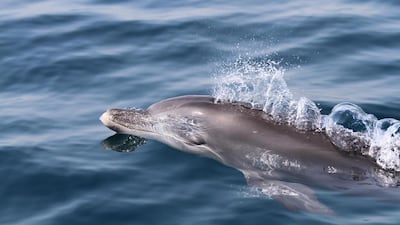Information from the public used to put data on the UAE’s first interactive tracking map for the mammals and provide valuable information for the experts.
DUBAI // Data collected on the UAE’s first dolphin map has been released, showing several hundred sightings of the popular mammals in the country’s coastal waters.
For the past three years, members of the public shared details of where and when they spotted dolphins, with 419 sightings recorded, mainly in Abu Dhabi and Dubai.
These provided the UAE Dolphin Project important data about the country’s dolphin populations, of which little was known.
Dr Ada Natoli, a dolphin expert who coordinated the implementation of the map in 2013, hopes the data collected will raise public awareness of the presence of dolphins in local waters and lead to new conservation laws.
“This way of engaging the public really makes a difference in understanding where these species are, especially in areas where there is scarce information available,” Dr Natoli said.
“Citizen science” has been used successfully around the world to support research on whales, dolphins and other species.
_____
› See the compiled map here: Recorded sightings in Abu Dhabi and Dubai - interactive
_____
The map data was logged onto a database by a group of volunteers, including Dina Abedini.
The 16-year-old student said the work was sometimes tedious but was worth it. “If you want to achieve a goal, you have to work hard for it,” she said.
“I love dolphins so it was a great opportunity to combine something fun with something useful.”
While details of dolphin sightings in neighbouring countries such as Oman, Kuwait and Saudi Arabia were also logged on the UAE map, most were of sightings made in Dubai and Abu Dhabi waters.
In Dubai, many sightings were recorded around The Palm Jumeirah and along Jumeirah beach, while some dolphins were spotted in the Creek.
In Abu Dhabi, some dolphins went into the mangrove canals, reaching Al Raha Beach.
The area in front of Emirates Palace hotel and Saadiyat Island were the places most frequented by dolphins in Abu Dhabi.
On Saadiyat, a permanent land observation point was set up at Park Hyatt Hotel, with permission from the Tourism Development and Investment Company, because of the high number of sightings.
Most of the dolphins seen belonged to three species – the Indo-Pacific humpbacked dolphin, the Indo-Pacific bottlenose dolphin and the finless porpoise.
“The good thing is that they are still here despite our massive impact on the marine environment,” Dr Natoli said.
“We really need to make sure these dolphins are protected somehow.
“This needs some attention by the authorities and more dedicated research.”
She was hopeful it could also lead to changes in law to protect the dolphins.
Measures could include reducing boat speeds and regulating boat traffic as well as jet ski use in waters frequented by dolphins.
The information collected from the dolphin map has been a vital help in a project Dr Natoli started in 2014 to study the UAE’s dolphin populations.
She has been conducting a boat-based survey in Dubai that will eventually help her to gauge population numbers.
About 41 per cent of the reports filed by members of the public were paired with pictures or video, which allowed Dr Natoli to recognise individual dolphins she has previously seen in Dubai.
Repeat sightings can provide information about the animals’ movement and bring more understanding about the type of habitats that dolphins in UAE waters prefer, she said.
To get involved with the project and report a dolphin sighting, email information about the date, time and location of the encounter to sighting@uaedolphinproject.org.
Pictures and videos are also welcome.
newsdesk@thenational.ae

